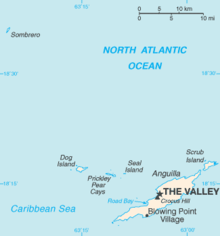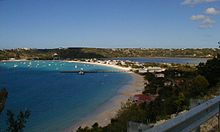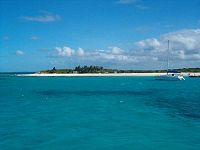Anguilla (dependency)
Anguilla (in English: Anguilla) is a British Overseas Territory located in the Caribbean, specifically in the extreme north of the Windward Islands, in the Lesser Antilles. It is one of the 17 non-autonomous territories under the supervision of the United Nations Decolonization Committee, in order to eliminate colonialism. Its capital is El Valle. The archipelago includes the island of Anguilla and some nearby islets and has maritime borders with the island of Saint Martin to the southeast. To the west lie the British Virgin Islands.
In recent years, Anguilla has become one of the most popular tax havens internationally, since the State does not collect any kind of taxes or commissions from individuals and corporations. In April 2011, in view of its deficit growing, introduced an "Interim Stabilization Tax" of 3%, the first form of tax on the island.
Etymology
The name comes from eel, a fish whose body is elongated in shape similar to a snake, in Latin: anguis.
The elongated and low shape of the island gave rise to the name, which may also be a translation from Taino: malliouhana, sea serpent, indigenous name of the place. It is attributed to Cristóbal Columbus who sighted the island in 1493.
With the arrival of the British, it took on the anglicized form of Anguilla.
History
Pre-colonization
Before the arrival of the Europeans, the island was called Malliouhana, which means 'arch-shaped sea serpent'. It was inhabited by the indigenous Arahuaco people, who were engaged in the production of corn, cotton, sweet potatoes and the fishing. It was discovered in 1493 by Christopher Columbus, and its name "Anguilla" this is probably due to its elongated shape. The first known mention under its current name is by the navigator Pierre Laudonnaire, who sighted it with a French expedition in 1556.
Dutch colonization
In 1631 the Dutch West India Company established a fort on the island, which was destroyed by the Spanish in 1633 before the capture of the island of Saint Martin.
British Colonization
Anguilla was colonized by Englishmen from St. Kitts and Nevis in 1650. In 1656 there was an attack by the Carib people. In 1698 there was an attempted conquest by Ireland and in 1745 and 1756 by France; all failed. It was administered by the United Kingdom until 1825, when it passed to the administration of Saint Kitts and Nevis against the wishes of the inhabitants of Anguilla. Since then, on several occasions, Anguilla has tried to secede.
Dependency
On July 11, 1967, a referendum on autonomy was held, won by the separatists (1,813 votes against 5), proclaiming their independence unilaterally on June 17. After several days of tension when the autonomy approved in the referendum was not granted and the only four British on the island were expelled, on March 19, 1969 British troops occupied the island, without resistance, a situation that lasted until September 15.
Finally in 1971, under legislation called the Anguilla bill, the island was administered by a British commissioner and an Island Council. It obtained British dependency status in 1976 with administrative autonomy, thanks to the leader of the Island Council Ronald Webster, and was consolidated in 1980, formally separating from the State associated with Saint Kitts and Nevis.
In 1992 it was admitted as an associate member of the Caribbean Community (CARICOM). In 1995, Hurricane Luis wreaked great havoc on the archipelago, especially the agricultural sector.
Government and politics
Anguilla is under the Constitutional Order of April 1, 1982, as amended in 1990.
The Head of State is King Charles III of the United Kingdom, represented by the Governor who is appointed by the King. The Head of Government is the Chief Minister who is appointed by the governor within the majority bloc of the Assembly, who must form an Executive Council approved by said chamber. As of 2020 the position of Head of Government was renamed Prime Minister.
The Assembly is unicameral with eleven seats; seven elected by popular vote, two ex officio members and two appointed by the governor; for a period of five years. There is a Grand Court (with a judge sent from the Supreme Court of the Eastern Caribbean).
Dileeni Daniel-Selvaratnam has served as Governor since January 18, 2021. Ellis Webster has been Prime Minister since June 30, 2020.
The Anguilla Social Security Board has been a full member of the Inter-American Conference on Social Security (CISS) since 1993.
Political parties
The main political groups are:
- Anguilla National Alliance (ANA)
- Strategic Alternative of Anguilla (ANSA)
- United Front of Anguilla (AUF)
- United Movement of Anguilla (AUM)
- Democratic Party of Anguilla (ADP)
- Anguilla Progressive Party (APP)
- United Party of Anguilla (PUA)
- Anguilla Teachers Union (ATU)
Political-administrative organization
It does not have a proper political-administrative division. Although the islands can be pointed out as the most representative division. The islands that make up the territory are:
- Anguilla
- Anguilla
- Dog
- Little Scrub
- Cayos Prickly Pear
- Sandy
- Scrub
- Seal
- Hat.
There are 9 districts that make up the island.
Geography
The archipelago is located in the Caribbean, specifically in the extreme north of the Windward Islands in the Lesser Antilles; includes the inhabited island of Anguilla and the uninhabited islands of Scrub, Dog, and Sombrero; and some nearby islets, also uninhabited.
The terrain is generally rocky and low elevation. There are only a few small lagoons on the island of Anguilla.
Climate
The climate is tropical, with an average temperature of 27 °C. The warmest period is from July to October and the coldest is from December to February. The average annual rainfall is 900 mm, the wettest months are September and October and the driest are February and March. The island receives two tropical storms per year and sudden hurricanes, which occur between July and November. The island suffered damage in 1995 from Hurricane Luis, severe flooding from Hurricane Lenny, and devastating damage in 2017 from Hurricane Irma.
| Month | Ene. | Feb. | Mar. | Open up. | May. | Jun. | Jul. | Ago. | Sep. | Oct. | Nov. | Dec. | Annual |
|---|---|---|---|---|---|---|---|---|---|---|---|---|---|
| Average temperature (°C) | 28 | 28 | 28 | 28 | 30 | 31 | 31 | 31 | 31 | 30 | 29 | 28 | 30 |
| Average temperature (°C) | 26 | 26 | 26 | 27 | 27 | 28 | 29 | 29 | 29 | 28 | 27 | 26 | 27 |
| Temp. medium (°C) | 23 | 23 | 23 | 25 | 25 | 26 | 26 | 26 | 26 | 26 | 25 | 24 | 23 |
| Source: Weatherbase | |||||||||||||
Economy
Anguilla has few natural resources, and the economy is highly dependent on tourism, foreign banking, lobster fishing and remittances from its émigrés. The economy, especially the tourism sector, suffered the devastating effects of Hurricane Luis in 1995, but recovered in 1996. As the tourism sector has grown, it has also been able to help the construction sector, which has grown strongly. Foreign banking is established, but it is very small, although it is also booming.
The main products it produces and exports are salt, fish, lobsters, concrete blocks, cattle, tobacco and rum. The issuance of postage stamps intended mainly for philatelic collecting is also a source of income for its economy. The Eastern Caribbean dollar is used as currency in the archipelago.
Transportation
Aerial
Anguilla is served by Clayton J. Lloyd International Airport (until July 4, 2010 known as Wallblake Airport). The airport's main runway is 5,462 feet (1,664.8 m) in length and can handle medium-sized aircraft. It has flights that operate to various Caribbean destinations through the regional operator LIAT, local charter airlines and others. Although there are no direct flights to the Americas or continental Europe, the airport can handle narrow-body jets such as the Boeing 727 and Boeing 737.
Road
Apart from taxis, there is no public transportation on the island. Cars drive on the left.
Boats
There are regular ferries from Saint Martin/Sint Maarten to Anguilla. It's about a twenty minute drive from Marigot, St. Martin to Blowing Point, Anguilla. Ferries begin service at 7:00 a.m. m. There is also a charter service, from Blowing Point, Anguilla to Princess Juliana Airport to allow for easier transfers. This mode of travel is the most common method of transportation between Anguilla and St. Martin or St. Maarten.
Demographics
According to CIA estimates, in 2012 Anguilla had a population of approximately 15,423. The entire population of the archipelago is concentrated on the main island of Anguilla. The official language of Anguilla is English. According to an estimated 2011 ethnographic report, the Afro-Caribbean population represents 85.3% of the total population. 4.9% are Hispanic (without further specification) and minority groups of native populations complement the description.
Religion
The majority of the population is Christian, with Protestant groups being the largest (with Anglican and Methodist majorities and Adventist and Baptist minorities). There are also Catholics (served by the Diocese of Saint John's-Basseterre, with see Saint John in Antigua and Barbuda 3.2% in 1992 and 6.8% in 2011) and a Rastafarian minority.
Christian churches did not have a consistent or strong presence during the early period of English colonization; the spiritual and religious practices of Europeans and Africans tended to reflect their regional origins. As early as 1813, Christian ministers were formally ministering to enslaved Africans and promoting literacy among converts. The Wesleyan (Methodist) Missionary Society of England built churches and schools beginning in 1817.
| Religion | 1992 | 2001 |
|---|---|---|
| Anglican | 40.4 | 29,0 |
| Methodism | 33.2 | 23.9 |
| Adventist Church | 7.0 | 7.6 |
| Baptist | 4.7 | 7.3 |
| Catholicism | 3.2 | 5.7 |
| Episcopal | - | 7.6 |
| Pentecostalism | - | 7.7 7.7 |
| Jehovah ' s Witnesses | - | 0.7 |
| Rastafari | - | 0.7 |
| Evangelical | - | 0.5 |
| Plymouth Brothers | - | 0.3 |
| Islam | - | 0.3 |
| Presbyterianism | - | 0.2 |
| Hinduism | - | 0.4 |
| Judaism | - | 0.1 |
| None | - | 4.0 |
| Other | 10.7 | 3.5 |
| Not declared | 0.7 | 0.3 |
Languages
Today, most people on Anguilla speak a British-influenced variety of Standard English. Other languages are also spoken on the island, including varieties of Spanish, Chinese, and the languages of other immigrant communities. However, the most common language other than standard English is Island Creole, which is mirrored in English (not to be confused with Antillean Creole ("French Creole"), spoken in French islands such as Martinique and Guadeloupe). It is referred to locally with terms such as "dialect" (pronounced "dialek"), "Anguilla Talk" or "Anguillian". It has its main roots in the early varieties of English and West African languages, and is similar in its structural features to the dialects spoken on the Anglophone islands throughout the eastern Caribbean.
Linguists interested in the origins of Anguilian and other Caribbean creoles point out that some of its grammatical features can be traced back to African languages, while others can be traced back to European languages. Three significant areas have been identified for the identification of the linguistic origins of forced migrants who arrived before 1710: the Gold Coast, the Slave Coast, and the Windward Coast.
Sociohistorical information from Anguilla's archives suggests that Africans and Europeans formed two distinct, but perhaps overlapping, language communities in the early phases of the island's colonization. It is believed that the "angulano" it emerged as the language of the masses as time passed, slavery was abolished and the local population began to consider themselves "belonging" to Anguilla society.
Culture
The culture of Anguilla is a reflection of the mixture between the traditions and customs of the Amerindians and the English colonizers. In 1993, the government founded the Anguilla National Trust, an institution in charge of maintaining, protecting and disseminating the natural, historical, archaeological and cultural heritage of the archipelago.
Parties
| Date | Name in Spanish | Local name |
|---|---|---|
| 1 January | New Year | New Year’s Day |
| Friday♪ | Good Friday | Good Friday |
| Monday♪ | Easter Monday | Easter Monday |
| 1 May | Labour Day | Labour Day |
| Thursday♪ | Ascension | Ascension |
| Monday♪ | Monday of Pentecost | Whit Monday |
| 30 May | Day of Anguilla | Anguilla Day |
| 2nd Saturday June | King's birthday | King's Birthday |
| 1 August | Summer Fair | Summer Bank Holiday |
| 1.♪ Thursday August | Thursday of August | August |
| 5 August | Constitutional Day | Constitution Day |
| 19 December | Day of Separation | Separation Day |
| 26 December | Day of St. Stephen | Boxing Day |
| 27 December | Day of St. Stephen | Boxing Day |
| (*) Movable | ||
Gastronomy
Anguilla's cuisine is influenced by that of the Caribbean, Spanish, French and English natives. Seafood is plentiful, mainly lobster, shrimp, crab, snails, among others. Salt is a staple in Anguilla, eaten alone or in stews, stews, or soups. Livestock is limited due to the small size of the island, people use poultry, pigs, goats and sheep, along with imported meat. Goat meat is the most consumed, being used in various dishes. The foods are rice, yams, sweet potatoes and bread.
Sports
One of the main sports in Anguilla is regattas, especially sailing. As in many former British colonies cricket is a widely practiced sport, rugby (represented in Anguilla by Anguilla Eels RFC) and soccer among other sports are also practiced.
The national team is considered one of the worst in Concacaf and in the world, since it has not won more than 5 games in its entire history. At the club level, its national league was founded in 1997 and the most winning team is Roaring Lions FC, with 9 titles. Never has a team from Anguilla represented the unit in international tournaments, such as the CFU Club Championship.
Contenido relacionado
Mali flag
Capsule
Saddam Hussein




